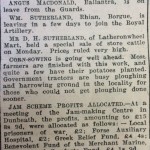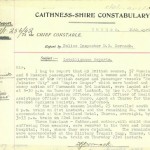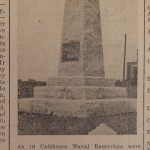On 20 April, the USS Wasp delivered a squadron of Spitfire fighters to Malta; although the planes were destroyed on the ground by the Luftwaffe before they could get into action, this marked a clear commitment by the Allies to defend the island. On 23 April in response to the bombing of Lubeck in March, the Luftwaffe began what came to be known as the “Baedeker raids”, targeting British cities of cultural or historical importance and named after the famous German guidebook; the first raid was on Exeter.
 Back in Caithness, as the John O’Groat Journal reported for Dunbeath, “Corn-sowing is going well ahead. Most farmers are finished with this work, and quite a few have their potatoes planted. Government tractors are busy ploughing and harrowing ground in the locality for those who could not get ploughing done sooner.”
Back in Caithness, as the John O’Groat Journal reported for Dunbeath, “Corn-sowing is going well ahead. Most farmers are finished with this work, and quite a few have their potatoes planted. Government tractors are busy ploughing and harrowing ground in the locality for those who could not get ploughing done sooner.”
On 23 April the police at Wick had the melancholy duty of passing on news of two tragic  aircraft accidents to the RAF at Inverness. “Two British “Hudson” aircraft crashed this morning – one at Hillhead, Wick … at approximately 02.30 hours, and the other at Blingery Hill … at approximately 03.55 hours. The machines caught fire and were completely destroyed. The crews were killed (4 men in each crew). The machine which crashed at Hillhead struck the wall of a dwelling-house, whereby the wall was damaged and a woman in bed inside was slightly injured.”
aircraft accidents to the RAF at Inverness. “Two British “Hudson” aircraft crashed this morning – one at Hillhead, Wick … at approximately 02.30 hours, and the other at Blingery Hill … at approximately 03.55 hours. The machines caught fire and were completely destroyed. The crews were killed (4 men in each crew). The machine which crashed at Hillhead struck the wall of a dwelling-house, whereby the wall was damaged and a woman in bed inside was slightly injured.”
 The police also reported the arrival of more survivors at Scrabster on 24 April: “Sir, I beg to report that 49 British seamen, 57 Russian seamen and 8 Russian passengers, including 4 women and 2 children, survivors of the British cargo and passenger vessels “New Westminster City” and “Empire Coupar”, which were bombed and sunk by enemy action off Murmansk on 3rd instant, were landed at Scrabster at 5-30 p.m. on Tuesday 21st instant by the S.S. “St Ninian”… Three Russians – father, and mother, with child who was suffering from measle4s, were removed to the Town and County Hospital, Wick.” The Empire Cowper had formed part of Convoy PQ-10 taking supplies to Russia, and was sunk with the loss of nine of her crew.
The police also reported the arrival of more survivors at Scrabster on 24 April: “Sir, I beg to report that 49 British seamen, 57 Russian seamen and 8 Russian passengers, including 4 women and 2 children, survivors of the British cargo and passenger vessels “New Westminster City” and “Empire Coupar”, which were bombed and sunk by enemy action off Murmansk on 3rd instant, were landed at Scrabster at 5-30 p.m. on Tuesday 21st instant by the S.S. “St Ninian”… Three Russians – father, and mother, with child who was suffering from measle4s, were removed to the Town and County Hospital, Wick.” The Empire Cowper had formed part of Convoy PQ-10 taking supplies to Russia, and was sunk with the loss of nine of her crew.
Finally this week, the John O’Groat Journal reported the erection of a memorial in Saint John, New Brunswick,  Canada, to the crew of the HMS Jervis Bay which had been formed part of convoy HX-84 from Halifax, Nova Scotia, to Britain in 1940. She had been sunk by the German pocket battleship Admiral Scheer with 19 Caithness Naval Reservists on board, only nine of whom survived. The plaque reads: “In Honoured Memory of Captain E.S. Fogarty Fegen V.C. Officers and Men of H.M.S. Jervis Bay Who Gave Their Lives In Gallant Action Against Overwhelming Odds With A German Raider In The North Atlantic November 5 1940 In Order That 36 Ships Under Their Care Might Be Saved.”
Canada, to the crew of the HMS Jervis Bay which had been formed part of convoy HX-84 from Halifax, Nova Scotia, to Britain in 1940. She had been sunk by the German pocket battleship Admiral Scheer with 19 Caithness Naval Reservists on board, only nine of whom survived. The plaque reads: “In Honoured Memory of Captain E.S. Fogarty Fegen V.C. Officers and Men of H.M.S. Jervis Bay Who Gave Their Lives In Gallant Action Against Overwhelming Odds With A German Raider In The North Atlantic November 5 1940 In Order That 36 Ships Under Their Care Might Be Saved.”

